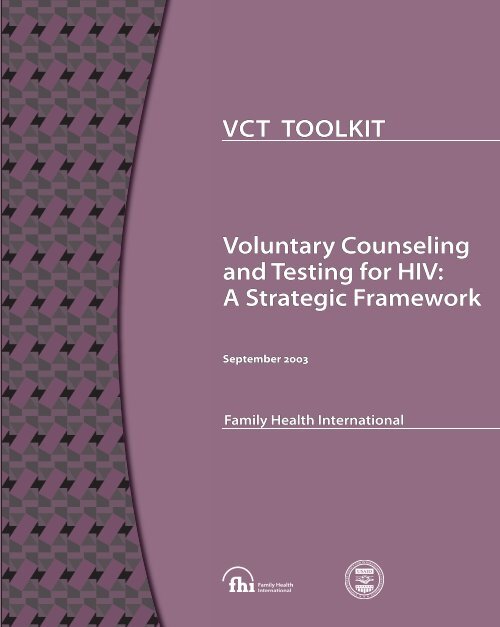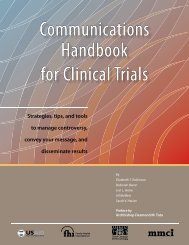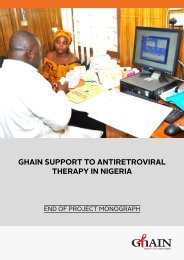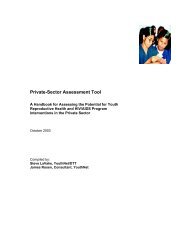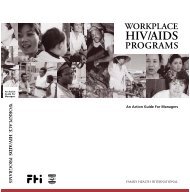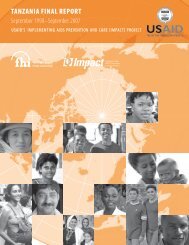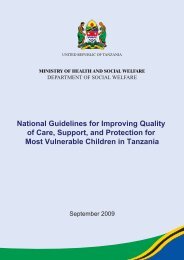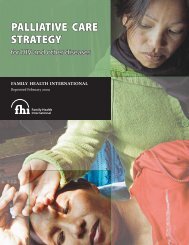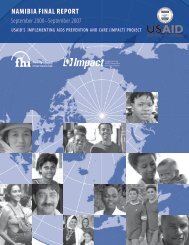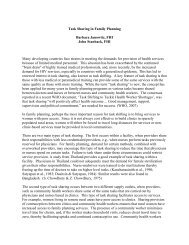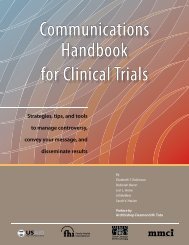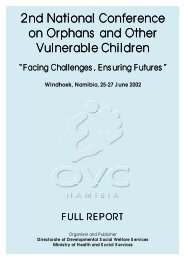Voluntary Counseling and Testing for HIV: A Strategic ... - FHI 360
Voluntary Counseling and Testing for HIV: A Strategic ... - FHI 360
Voluntary Counseling and Testing for HIV: A Strategic ... - FHI 360
Create successful ePaper yourself
Turn your PDF publications into a flip-book with our unique Google optimized e-Paper software.
VCT TOOLKIT<br />
<strong>Voluntary</strong> <strong>Counseling</strong><br />
<strong>and</strong> <strong>Testing</strong> <strong>for</strong> <strong>HIV</strong>:<br />
A <strong>Strategic</strong> Framework<br />
September 2003<br />
Family Health International
VCT TOOLKIT<br />
<strong>Voluntary</strong> <strong>Counseling</strong><br />
<strong>and</strong> <strong>Testing</strong> <strong>for</strong> <strong>HIV</strong>:<br />
A <strong>Strategic</strong> Framework<br />
September 2003<br />
Family Health International
ACKNOWLEDGEMENTS<br />
This guide was prepared by Gloria Sangiwa based on her long experience in Tanzania <strong>and</strong> Zimbabwe <strong>and</strong> recently as director<br />
of Psychosocial Care <strong>for</strong> the Institute <strong>for</strong> <strong>HIV</strong>/AIDS, Arlington, Va., USA. Technical input was provided by Eric van Praag, Gina<br />
Dallabetta <strong>and</strong> Deborah Boswell; editorial support was provided by Robert Ritzenthaler; design by Jimmy Bishara.<br />
For queries <strong>and</strong> sharing of experiences, please contact:<br />
Gloria Sangiwa (gsangiwa@fhi.org)<br />
Family Health International<br />
Institute <strong>for</strong> <strong>HIV</strong>/AIDS<br />
2101 Wilson Boulevard, Suite 700<br />
Arlington, VA 22201 USA<br />
Tel: 1-703- 516-9779<br />
Fax: 1-703-516-9781<br />
URL: www.fhi.org<br />
© 2003 Family Health International (<strong>FHI</strong>). All rights reserved. This book may be freely reviewed, quoted, reproduced<br />
or translated, in full or in part, provided the source is acknowledged. This guide has been funded by the U. S. Agency <strong>for</strong><br />
International Development (USAID) through <strong>FHI</strong>’s Implementing <strong>HIV</strong>/AIDS Prevention <strong>and</strong> Care (IMPACT) Project, Cooperative<br />
Agreement HRN-A-00-97-00017-00.<br />
<strong>Voluntary</strong> <strong>Counseling</strong> <strong>and</strong> <strong>Testing</strong> <strong>for</strong> <strong>HIV</strong>: A <strong>Strategic</strong> Framework
TABLE OF CONTENTS<br />
INTRODUCTION 1<br />
STATE-OF-THE-ART 2<br />
<strong>FHI</strong> GOALS AND OBJECTIVES 2<br />
<strong>FHI</strong>’S TECHNICAL AND PROGRAMMATIC APPROACHES 2<br />
INTERVENTION-LINKED RESEARCH 5<br />
MONITORING AND EVALUATION 5<br />
LINKAGES AND PARTNERSHIPS 6<br />
ILLUSTRATIVE ACTIVITIES 6<br />
FURTHER READING 9<br />
APPENDIX 1 10<br />
APPENDIX 2 12<br />
VCT Toolkit
<strong>Voluntary</strong> <strong>Counseling</strong> <strong>and</strong> <strong>Testing</strong> <strong>for</strong> <strong>HIV</strong>: A <strong>Strategic</strong> Framework
INTRODUCTION<br />
The <strong>HIV</strong> epidemic continues to spread at an alarming rate,<br />
with over 14,000 new infections per day. While the epidemic<br />
is now spreading rapidly in some parts of Asia <strong>and</strong> Latin<br />
America <strong>and</strong> Caribbean, sub-Saharan Africa continues to<br />
bear the greatest burden of disease. <strong>HIV</strong> prevalence exceeds<br />
30 percent among sexually active adults in some African<br />
cities, <strong>and</strong> AIDS is the leading cause of death in major cities<br />
within sub-Saharan Africa.<br />
More than 90 percent of the estimated 42 million persons<br />
living with <strong>HIV</strong>/AIDS (PLHA) around the world live in resourceconstrained<br />
countries in Africa, Asia, Latin America <strong>and</strong><br />
Caribbean. But despite the very high number of people<br />
already living with <strong>HIV</strong>/AIDS, it is estimated that less than 10<br />
percent are aware they are infected, mainly because of the<br />
limited availability, access, <strong>and</strong> use of voluntary counseling<br />
<strong>and</strong> testing (VCT) <strong>for</strong> <strong>HIV</strong>. This fact greatly hinders ef<strong>for</strong>ts to<br />
respond to the AIDS epidemic, as people have to know if<br />
they are infected if they are to access services. Figure 1 shows<br />
Figure 1<br />
Source: UNAIDS, “Report on the Global<br />
<strong>HIV</strong>/AIDS Epidemic-July 2002” www.unaids.org/<br />
Barcelona, accessed July 8, 2002).<br />
�������� ��������<br />
��� ������ ������<br />
���� ��� ����<br />
�����������<br />
����������<br />
�������� ���<br />
������� ������<br />
����������� ��������<br />
�� ������ ��� ����<br />
�������<br />
����� ���������� ��<br />
���������� ��� ������<br />
���������<br />
����������<br />
��� �������<br />
������� ���������� �������<br />
��� ������������� ������<br />
the benefits of VCT as an entry point to prevention <strong>and</strong> care<br />
services.<br />
<strong>HIV</strong> VCT has long been a component of <strong>HIV</strong> prevention <strong>and</strong><br />
care ef<strong>for</strong>ts among affected communities in developed<br />
countries, <strong>and</strong> is now increasingly being implemented<br />
in resource-constrained countries. In the presence of a<br />
high prevalence <strong>and</strong> growing awareness of <strong>HIV</strong>, several<br />
governments have included VCT services as a major<br />
component of their national <strong>HIV</strong> prevention <strong>and</strong> care<br />
programs.<br />
Because of the recognized importance of <strong>HIV</strong> VCT in<br />
national AIDS control programs, <strong>HIV</strong> VCT services are<br />
in various stages of development in many resourceconstrained<br />
countries. Where available (these services tend<br />
to be of limited quality <strong>and</strong> coverage) they are implemented<br />
by nongovernmental organizations (NGOs) <strong>and</strong> some public<br />
<strong>and</strong> private health centers, clinics, <strong>and</strong> hospitals.<br />
����������� ��������<br />
������<br />
�������<br />
���������������<br />
������������<br />
�������� �����<br />
���������� ��<br />
������������� ����������<br />
��� ����� ��� �����������<br />
��� ���<br />
VCT Toolkit 1
2<br />
STATE OF THE ART<br />
Several observational studies were first to suggest the<br />
feasibility <strong>and</strong> effectiveness of <strong>HIV</strong> VCT. For example, in<br />
1991, a study conducted among 149 discordant couples<br />
(one <strong>HIV</strong>-infected <strong>and</strong> the other <strong>HIV</strong>-negative) in Kinshasa,<br />
Congo, demonstrated a marked increase in condom use<br />
among these couples, from less than 5 percent be<strong>for</strong>e<br />
the <strong>HIV</strong> VCT intervention to 70 percent following the<br />
intervention [Kamenga et al., 1991]. Another study—carried<br />
out in Rw<strong>and</strong>a on the impact of <strong>HIV</strong> VCT among a cohort<br />
of women—reported an increase in condom use from<br />
only 7 percent having ever used condom be<strong>for</strong>e the<br />
intervention to 16 percent among <strong>HIV</strong>-seronegative <strong>and</strong><br />
35 percent among <strong>HIV</strong>-seropositive women after the<br />
intervention [Allen et al., 1992]. Finally, an analysis of data<br />
from 3,000 clients receiving <strong>HIV</strong> VCT at the AIDS In<strong>for</strong>mation<br />
Center in Ug<strong>and</strong>a demonstrated substantial reduction<br />
in risk behaviors at three <strong>and</strong> six months following the<br />
intervention [Campbell et al].<br />
Findings from the above observational studies have been<br />
confirmed by a controlled study conducted by <strong>FHI</strong> in<br />
collaboration with the Joint United Nations Programme<br />
on <strong>HIV</strong>/AIDS (UNAIDS) <strong>and</strong> the World Health Organization<br />
(WHO). This multi-center (including Kenya, Tanzania,<br />
Trinidad <strong>and</strong> Tobago) r<strong>and</strong>omized controlled study<br />
coordinated by the Center <strong>for</strong> AIDS Prevention Studies<br />
documented a 43 percent reduction in the occurrence<br />
of unprotected sex among those who received <strong>HIV</strong> VCT<br />
[the voluntary <strong>HIV</strong>-1 <strong>Counseling</strong> <strong>and</strong> <strong>Testing</strong> Study Group]. In<br />
addition to the behavioral data, this study demonstrated<br />
that <strong>HIV</strong> VCT is highly cost-effective. The cost per disability<br />
adjusted life year saved (DALY) was US$12.77 in Kenya<br />
<strong>and</strong> US$17.78 in Tanzania. This compares favorably to<br />
other health interventions in resource- poor settings, <strong>and</strong><br />
the cost-effectiveness can be significantly improved by<br />
targeting couples <strong>and</strong> populations most at risk <strong>for</strong> <strong>HIV</strong><br />
infection [Sweat et al.].<br />
Based on this existing data <strong>and</strong> evidence, there is currently<br />
a consensus about the efficacy <strong>and</strong> cost-effectiveness<br />
of the <strong>HIV</strong> VCT intervention <strong>for</strong> <strong>HIV</strong> prevention <strong>and</strong> care.<br />
<strong>HIV</strong> VCT has become or is being advocated as a major<br />
component of any comprehensive national AIDS control<br />
program in many countries. Major roles recognized <strong>for</strong> <strong>HIV</strong><br />
VCT include:<br />
• Enabling <strong>HIV</strong> VCT clients to cope <strong>and</strong> make personal<br />
decisions related to <strong>HIV</strong>/AIDS;<br />
<strong>Voluntary</strong> <strong>Counseling</strong> <strong>and</strong> <strong>Testing</strong> <strong>for</strong> <strong>HIV</strong>: A <strong>Strategic</strong> Framework<br />
• Assisting <strong>HIV</strong> VCT clients to initiate <strong>and</strong> maintain<br />
preventive behaviors;<br />
• Serving as an early referral <strong>and</strong> entry point to <strong>HIV</strong><br />
care <strong>and</strong> support services, <strong>and</strong> to other prevention<br />
services, including family planning;<br />
• Helping to combat stigma <strong>and</strong> discrimination in the<br />
community.<br />
<strong>FHI</strong> GOALS AND OBJECTIVES<br />
<strong>FHI</strong>’s goal on <strong>HIV</strong> VCT is to help reduce <strong>HIV</strong> transmission<br />
through behavior change, especially among populations<br />
most at risk <strong>for</strong> <strong>HIV</strong> infection, <strong>and</strong> help meet the care <strong>and</strong><br />
support needs of PLHA, their families, <strong>and</strong> communities.<br />
Specific objectives of our <strong>HIV</strong> VCT ef<strong>for</strong>ts are to:<br />
• Improve the local capacity to provide <strong>HIV</strong> VCT;<br />
• Improve/promote availability <strong>and</strong> use of <strong>HIV</strong> VCT<br />
services;<br />
• Promote functional linkages between <strong>HIV</strong> VCT<br />
services <strong>and</strong> other care <strong>and</strong> support services (AIDS<br />
care <strong>and</strong> the continuum of care services);<br />
• Promote strategies aimed at reducing stigma <strong>and</strong><br />
discrimination;<br />
• Contribute to the improvement of the quality of VCT<br />
services.<br />
<strong>FHI</strong>’S TECHNICAL AND PROGRAMMATIC<br />
APPROACHES<br />
Guiding Principles<br />
<strong>FHI</strong> recognizes that counseling is a culturally sensitive <strong>and</strong><br />
complex intervention. We there<strong>for</strong>e support working with<br />
in-country counterparts <strong>and</strong> the community, including<br />
PLHA, to develop culturally appropriate VCT services based<br />
on the client-centered* approach to counseling.<br />
Beyond the counseling sessions <strong>and</strong> testing of specimens (if<br />
desired by the client), <strong>HIV</strong> VCT is an important entry point to<br />
many other care <strong>and</strong> support services. There<strong>for</strong>e, exp<strong>and</strong>ing<br />
<strong>and</strong> promoting <strong>HIV</strong> VCT services must be done with special<br />
care to ensure that the needs of those using the promoted<br />
services will be met to the extent possible. For example,<br />
massive promotion of <strong>HIV</strong> VCT not coordinated with the<br />
development <strong>and</strong>/or strengthening of other care <strong>and</strong><br />
support services <strong>and</strong> referral networks may result in poor<br />
* A client in the context of VCT is any person—young or adult, feeling<br />
healthy or sick—who seeks a service where one receives <strong>HIV</strong> counseling<br />
<strong>and</strong> learns of his/her <strong>HIV</strong> serostatus.
quality services <strong>and</strong> fall short of meeting the needs of PLHA.<br />
For <strong>HIV</strong> VCT to fully play its role in <strong>HIV</strong>/AIDS prevention <strong>and</strong><br />
care, it must be of the best quality, available, <strong>and</strong> easily<br />
accessible to those who need such service. The existence of<br />
effective referral systems between <strong>HIV</strong> VCT <strong>and</strong> other care<br />
<strong>and</strong> support services—either in the same health facility or<br />
in the community—is critical in responding to the needs of<br />
people infected or affected by <strong>HIV</strong>/AIDS.<br />
Quality assurance of both <strong>HIV</strong> testing <strong>and</strong> counseling is<br />
critical to the success of <strong>HIV</strong> VCT services. <strong>FHI</strong> contributes<br />
to quality assurance by developing st<strong>and</strong>ard operating<br />
procedures, training, supervision <strong>and</strong> support of staff, <strong>and</strong><br />
establishing both internal <strong>and</strong> external quality control<br />
systems.<br />
<strong>FHI</strong>’s Approaches<br />
The increasing availability of <strong>and</strong> access to antiretroviral<br />
therapy (ART), interventions to prevent mother-to-child<br />
transmission on <strong>HIV</strong> (PMTCT), <strong>and</strong> other prevention <strong>and</strong><br />
care interventions dictate that individuals’ knowledge of <strong>HIV</strong><br />
status be increased as most of these interventions require<br />
knowing one’s <strong>HIV</strong> serostatus. <strong>FHI</strong> supports the need to<br />
tailor innovative approaches to <strong>HIV</strong> counseling <strong>and</strong> testing<br />
to this changing context of the <strong>HIV</strong>/AIDS epidemic.<br />
<strong>Counseling</strong> Approaches<br />
To respond to this imperative, <strong>FHI</strong> supports ef<strong>for</strong>ts to<br />
develop VCT approaches that are cost-effective, pragmatic,<br />
ethical, <strong>and</strong> adaptable to various needs <strong>and</strong> settings.<br />
To achieve large-scale implementation of <strong>HIV</strong> VCT, <strong>FHI</strong><br />
supports the notion—espoused by WHO <strong>and</strong> other<br />
international organizations—that it is critical to move<br />
beyond the idea of VCT as a package always to be provided<br />
in the exact way in all circumstances. Rather, VCT services<br />
must be adapted to respond to varying needs <strong>and</strong> contexts.<br />
<strong>HIV</strong> counseling <strong>and</strong> testing currently occur in three major<br />
contexts:<br />
• For those who want to know their serostatus. This is<br />
“traditional” VCT, offered <strong>for</strong> behavior change in the<br />
prevention of <strong>HIV</strong>;<br />
• Where it is medically indicated in the context of<br />
clinical care <strong>for</strong> diagnosis purposes;<br />
• For PMTCT.<br />
To respond to these different circumstances, pre-test<br />
counseling might be adapted. For example, in the context<br />
of clinical diagnosis <strong>for</strong> the medically indicated, less<br />
emphasis might be put on risk assessment during pre-test<br />
counseling to focus more on disclosure of <strong>HIV</strong> status <strong>and</strong><br />
care <strong>and</strong> support. In the context of PMTCT, in antenatal<br />
(ANC) clinics with heavy workloads, women may be seen<br />
in groups <strong>for</strong> pre-test counseling. While group pre-test<br />
in<strong>for</strong>mation sessions can be employed at VCT service sites<br />
with heavy client flow to reduce the length of individual/<br />
pre-test counseling <strong>and</strong> reduce the burden on counselors,<br />
these should not be seen as a replacement to pre-test<br />
counseling.<br />
<strong>FHI</strong> emphasizes the requirement that regardless of the<br />
VCT approach used, there remain a number of minimum<br />
st<strong>and</strong>ards which remain critical – the voluntary nature<br />
of <strong>HIV</strong> testing, the need to obtain in<strong>for</strong>med consent,<br />
confidentiality of the process, <strong>and</strong> access to high-quality<br />
supportive counseling. The process of obtaining in<strong>for</strong>med<br />
consent must ensure that sufficient in<strong>for</strong>mation is provided,<br />
that the in<strong>for</strong>mation is understood, <strong>and</strong> that an in<strong>for</strong>med<br />
choice is made by the individual offered the <strong>HIV</strong> test under<br />
each circumstance.<br />
In addressing those who want to know their serostatus<br />
(traditional VCT), <strong>FHI</strong> tailors the design <strong>and</strong> implementation<br />
of <strong>HIV</strong> VCT services to the unique epidemiological,<br />
behavioral, <strong>and</strong> economic context of each country<br />
<strong>and</strong> setting to maximize their effectiveness <strong>and</strong> costeffectiveness.<br />
We pay particular attention to the choice<br />
of <strong>HIV</strong> VCT service delivery models in each country <strong>and</strong><br />
setting. Both self-st<strong>and</strong>ing <strong>and</strong> integrated <strong>HIV</strong> VCT services<br />
have advantages <strong>and</strong> disadvantages. Selecting one<br />
approach over the other or going <strong>for</strong> a mix of both selfst<strong>and</strong>ing<br />
<strong>and</strong> integrated models must be done carefully,<br />
considering such factors as: choice of local authorities,<br />
target populations, level of stigma <strong>and</strong> discrimination in<br />
the community, management <strong>and</strong> administration ease,<br />
potential <strong>for</strong> linkages, existing dem<strong>and</strong> <strong>and</strong> likelihood of<br />
service utilization, equity issues, feasibility, ability to be<br />
replicated, etc. Whatever the model of service delivery,<br />
every ef<strong>for</strong>t must be made to ensure that the counseling<br />
provided remains of the highest quality possible.<br />
<strong>Testing</strong> Approaches<br />
Choice of the <strong>HIV</strong> testing protocol must consider the<br />
local <strong>HIV</strong> epidemiology, the locally existing laboratory<br />
infrastructure, the volume of <strong>HIV</strong> testing (namely, number<br />
of people to be tested daily), the quality assurance capacity,<br />
the clients’ preference, the impact of the chosen protocol<br />
on provision of the service, <strong>and</strong> the cost implications of<br />
the chosen protocol. Various protocols <strong>and</strong> strategies<br />
can be considered, <strong>and</strong> it is normally the responsibility<br />
VCT Toolkit 3
4<br />
of government regulatory bodies — ministries of health,<br />
national AIDS control programs, national reference<br />
laboratories — to develop the most feasible testing<br />
strategies (st<strong>and</strong>ard testing algorithm) <strong>for</strong> the country.<br />
<strong>FHI</strong> supports current WHO recommendations of three<br />
testing strategies, depending on <strong>HIV</strong> prevalence in the<br />
population, the sensitivity <strong>and</strong> specificity of the antibody<br />
tests being used, <strong>and</strong> whether the objective is blood<br />
screening, surveillance, or diagnosis (Appendix 1 describes<br />
the three testing strategies.)<br />
The wide availability of high-quality, rapid <strong>HIV</strong> tests<br />
has helped VCT programs overcome one of their main<br />
problems — patients’ failure to return <strong>for</strong> test results.<br />
Using ELISA-based technology, VCT clients must typically<br />
wait at least 72 hours <strong>for</strong> their results. Experience in most<br />
VCT centers suggests that 20-40 percent of those tested<br />
do not return <strong>for</strong> their test results. In settings where<br />
service utilization has been low, introducing rapid tests<br />
has increased access to VCT services significantly. Rapid<br />
<strong>HIV</strong> assays have recently been found to have important<br />
applications <strong>for</strong> <strong>HIV</strong> prevention, as well as <strong>for</strong> care <strong>and</strong><br />
support interventions. For those who test negative, results<br />
can be communicated on the same day, providing an<br />
additional avenue <strong>for</strong> prevention strategies. Those who test<br />
positive can be referred early to clinical care <strong>and</strong> support<br />
services. Some view the waiting period <strong>for</strong> test results using<br />
ELISA technology as a time <strong>for</strong> reflection, giving pre-test<br />
counseling a greater impact. This can be accomplished with<br />
rapid testing by ensuring time between the pre-test <strong>and</strong><br />
blood-draw or finger-prick stage.<br />
The sensitivity <strong>and</strong> specificity of rapid tests currently on the<br />
market are comparable to those of ELISA. Studies looking<br />
at specific combinations of two or more different rapid <strong>HIV</strong><br />
tests have provided results as reliable as those from ELISA<br />
<strong>and</strong> Western Blot combinations, even in low-prevalence<br />
settings. There<strong>for</strong>e, <strong>FHI</strong> suggests that the choice between<br />
rapid tests <strong>and</strong> st<strong>and</strong>ard ELISA <strong>and</strong> Western Blot be made<br />
with the following advantages <strong>and</strong> disadvantages of each<br />
option in mind.<br />
The advantages of rapid tests include: speed of the test (less<br />
than 30 minutes), client is in<strong>for</strong>med of test result during the<br />
same visit, require less or no sophisticated infrastructure,<br />
do not require highly trained staff. But they have the<br />
following disadvantages: people do not always believe in<br />
their accuracy, less time <strong>for</strong> the counselor <strong>and</strong> the client to<br />
prepare <strong>for</strong> test results, especially positive results.<br />
<strong>Voluntary</strong> <strong>Counseling</strong> <strong>and</strong> <strong>Testing</strong> <strong>for</strong> <strong>HIV</strong>: A <strong>Strategic</strong> Framework<br />
The advantages of ELISA include: capacity to run large<br />
numbers of samples at once, perceived better accuracy by<br />
clients, cost declines once initial investment in equipment<br />
made. On the negative side, ELISA has the following<br />
disadvantages: samples have to be transported to a<br />
centralized location <strong>for</strong> testing, requires highly trained staff,<br />
waiting period of several days depending on volume of<br />
testing, <strong>and</strong> requires sophisticated infrastructure.<br />
The advent of rapid test technologies, especially those<br />
that use whole blood instead of serum, has also increased<br />
the options <strong>for</strong> testing protocols <strong>and</strong> procedures to<br />
accommodate different service settings <strong>and</strong> client<br />
preferences. These options are serial testing <strong>and</strong> parallel<br />
testing.<br />
• Serial testing: In serial testing, all persons are tested<br />
with a rapid <strong>HIV</strong> test. If the test is positive, a second,<br />
different rapid <strong>HIV</strong> test is per<strong>for</strong>med. Discordant test<br />
results are further tested with a third type of rapid<br />
<strong>HIV</strong> test. The tests are per<strong>for</strong>med in series.<br />
• Parallel testing: In parallel testing, all persons are<br />
tested using two tests simultaneously (in parallel).<br />
If the tests are discordant — which is estimated to<br />
occur less than one percent of the time — a third<br />
type of rapid test is used as “tiebreaker.”<br />
See Appendix 2 <strong>for</strong> a discussion of the relative advantages<br />
<strong>and</strong> disadvantages of parallel <strong>and</strong> serial testing, <strong>and</strong> <strong>for</strong> an<br />
illustrative costing exercise comparing the two approaches<br />
in different settings.<br />
Implementation<br />
While it is imperative that any client who requests <strong>HIV</strong><br />
testing receives it, in low- prevalence settings (less than<br />
1 percent) where the population is not at increased risk<br />
<strong>for</strong> <strong>HIV</strong>, <strong>HIV</strong> counseling <strong>and</strong> testing must be targeted<br />
to maximize cost-effectiveness. It is important to make<br />
special ef<strong>for</strong>ts to avail VCT services to particular groups<br />
(youth, couples, pre-marital couples, men who have sex<br />
with men, sex workers, injecting drug users, etc.) that may<br />
greatly benefit from such service. Of particular interest are<br />
adolescents. Given the declining age of onset of first sexual<br />
activity, investing in youth-friendly VCT services must be<br />
a priority <strong>for</strong> many nations, especially within sub-Saharan<br />
Africa.<br />
<strong>FHI</strong>’s programmatic approach includes the following<br />
planning <strong>and</strong> implementation steps:<br />
• Support baseline analysis, including identifying <strong>and</strong><br />
meeting with stakeholders, gathering background
in<strong>for</strong>mation on existing VCT services, conducting an<br />
inventory of care <strong>and</strong> support services, <strong>and</strong> exploring<br />
needs <strong>and</strong> expectations of potential VCT clients;<br />
• Support project design using in<strong>for</strong>mation gathered<br />
in bullet one above;<br />
• Support implementation of <strong>HIV</strong> VCT services;<br />
• Provide appropriate assistance with quality<br />
assurance <strong>and</strong> monitoring <strong>and</strong> evaluation.<br />
<strong>FHI</strong> supports countries in the following specific areas:<br />
Policy<br />
• Advocating <strong>for</strong> <strong>HIV</strong> VCT services to policymakers, <strong>and</strong><br />
leaders at various levels;<br />
• Developing national guidelines on <strong>HIV</strong> counseling<br />
<strong>and</strong> testing;<br />
• Developing st<strong>and</strong>ardized <strong>HIV</strong> counseling training<br />
curricula;<br />
• Developing appropriate <strong>HIV</strong> VCT training materials;<br />
• Involving the community to promote acceptability<br />
of <strong>HIV</strong> VCT services, acceptance of PLHA, <strong>and</strong><br />
reduction of stigma <strong>and</strong> discrimination.<br />
Service Promotion<br />
• Using appropriate media to advertise <strong>and</strong> promote<br />
<strong>HIV</strong> VCT services to increase dem<strong>and</strong> <strong>for</strong> <strong>HIV</strong> VCT.<br />
VCT Services<br />
• Assessing the availability, quality, <strong>and</strong> use of existing<br />
<strong>HIV</strong> VCT services;<br />
• Designing, implementing, <strong>and</strong> scaling up highquality<br />
<strong>HIV</strong> VCT services;<br />
• Training counselors in risk-reduction counseling <strong>and</strong><br />
in personal emotional support techniques;<br />
• Training laboratory personnel;<br />
• Supporting quality assurance (<strong>for</strong> example, quality<br />
control <strong>for</strong> <strong>HIV</strong> testing; supervision <strong>and</strong> quality<br />
control <strong>for</strong> <strong>HIV</strong> counseling);<br />
• Developing a directory of care <strong>and</strong> support services<br />
to facilitate referrals both to services within the<br />
health facility (<strong>for</strong> integrated VCT services) <strong>and</strong> within<br />
the greater community;<br />
• Establishing/promoting linkages between <strong>HIV</strong> VCT<br />
services <strong>and</strong> other care <strong>and</strong> support services as<br />
appropriate.<br />
Research <strong>and</strong> Evaluation<br />
• Providing ongoing technical assistance to improve<br />
implementation, monitoring, <strong>and</strong> evaluation of <strong>HIV</strong><br />
VCT services;<br />
• Supporting the development of a limited number<br />
of <strong>HIV</strong> VCT sites as learning centers <strong>and</strong> using<br />
experience gained there to exp<strong>and</strong> <strong>HIV</strong> VCT services<br />
in the country;<br />
• Supporting collection <strong>and</strong> dissemination of lessons<br />
learned.<br />
INTERVENTION-LINKED RESEARCH<br />
Many operational questions related to implementation<br />
of <strong>HIV</strong> VCT in resource-constrained countries remian<br />
unanswered. <strong>FHI</strong> strives to conduct well-designed,<br />
intervention-linked research as part of our <strong>HIV</strong> VCTsupported<br />
activities to improve <strong>HIV</strong> VCT service design <strong>and</strong><br />
implementation.<br />
Intervention-linked research questions include:<br />
• What is the impact of support groups on the longterm<br />
sustainability of behavior change achieved<br />
through <strong>HIV</strong> VCT?<br />
• What is the community impact of <strong>HIV</strong> VCT?<br />
• How can <strong>HIV</strong> VCT be integrated efficiently <strong>and</strong><br />
af<strong>for</strong>dably (inexpensively) in sexually transmitted<br />
infection (STI), family planning, <strong>and</strong> PMTCT services?<br />
• Are certain <strong>HIV</strong> VCT service delivery models more<br />
cost-effective than others?<br />
• What is the added value of parallel <strong>HIV</strong> testing on<br />
serial testing as recommended by WHO?<br />
MONITORING AND EVALUATION<br />
Monitoring <strong>and</strong> evaluation (M&E) is a critical component <strong>for</strong><br />
successfully implementing <strong>HIV</strong> VCT services. Well-designed<br />
<strong>and</strong> -conducted M&E of <strong>HIV</strong> VCT helps identify <strong>and</strong> correct<br />
potential problems on an ongoing basis <strong>and</strong> provides<br />
feedback during planning, design, <strong>and</strong> implementation of<br />
<strong>HIV</strong> VCT programs.<br />
M&E activities should address two relevant areas <strong>for</strong> service<br />
providers <strong>and</strong> policymakers:<br />
• Service delivery — how well <strong>HIV</strong> VCT is provided;<br />
• Program effectiveness — the intermediate outcomes<br />
<strong>and</strong> long-term impact that <strong>HIV</strong> VCT may have on the<br />
population receiving the service.<br />
VCT Toolkit 5
6<br />
Illustrative indicators include:<br />
Process indicators: service delivery/program<br />
output<br />
• Proportion of people in the community who know<br />
about the <strong>HIV</strong> VCT services;<br />
• Number of people counseled <strong>and</strong> tested at the <strong>HIV</strong><br />
VCT site (per month, per year);<br />
• Proportion of people counseled <strong>and</strong> tested who<br />
have returned to receive their test results;<br />
• Proportion of people testing <strong>HIV</strong> positive who have<br />
been referred to appropriate care <strong>and</strong> support<br />
services;<br />
• Proportion of people counseled <strong>and</strong> tested who<br />
state that they intend to in<strong>for</strong>m their partners;<br />
• Proportion of people counseled <strong>and</strong> tested who<br />
have in<strong>for</strong>med their partners (partner notification).<br />
Effectiveness indicators: intermediate program<br />
outcomes<br />
• Changes in <strong>HIV</strong>/STI-related risk behaviors among <strong>HIV</strong><br />
VCT clients <strong>and</strong> their partners;<br />
• Changes in behavior among people stating that they<br />
know their serostatus (collected through behavioral<br />
surveillance surveys, <strong>for</strong> example);<br />
• Changes in STI trends in sub-populations reached by<br />
the <strong>HIV</strong> VCT program;<br />
• Reduced stigmatization of, <strong>and</strong> discrimination<br />
against, people in the community affected by <strong>HIV</strong>/<br />
AIDS;<br />
• Increased community support <strong>for</strong> PLHA.<br />
Effectiveness indicators: expected program<br />
impact (long-term effects)<br />
• Changes in trends in <strong>HIV</strong> incidence/prevalence in the<br />
population or sub-populations served by <strong>HIV</strong> VCT<br />
programs;<br />
• Reduced mother-to-child transmission of <strong>HIV</strong> in<br />
women of childbearing age targeted by the <strong>HIV</strong> VCT<br />
programs;<br />
• Sustained changes in societal norms in the<br />
community reached by the <strong>HIV</strong> VCT programs.<br />
LINKAGES AND PARTNERSHIPS<br />
<strong>FHI</strong> recognizes the importance of linkages between <strong>HIV</strong><br />
VCT <strong>and</strong> our other prevention <strong>and</strong> care activities. <strong>HIV</strong> VCT<br />
is an important component of our prevention activities<br />
<strong>Voluntary</strong> <strong>Counseling</strong> <strong>and</strong> <strong>Testing</strong> <strong>for</strong> <strong>HIV</strong>: A <strong>Strategic</strong> Framework<br />
<strong>for</strong> risk reduction <strong>and</strong> is used as an entry point <strong>for</strong> our<br />
care activities such as tuberculosis (TB) prophylaxis <strong>and</strong><br />
treatment, medical care, PMTCT, establishment of support<br />
networks, etc. For example, in Kenya, <strong>HIV</strong> VCT is used as<br />
an entry point to treatment <strong>and</strong> prophylaxis activities <strong>for</strong><br />
TB. Our <strong>HIV</strong> VCT expertise is also used to support ongoing<br />
activities to prevent mother-to-child transmission of <strong>HIV</strong> in<br />
Kenya <strong>and</strong> Rw<strong>and</strong>a.<br />
In addition, <strong>FHI</strong> collaborates with NGOs, community-based<br />
organizations (CBOs), <strong>and</strong> other national <strong>and</strong> international<br />
organizations involved in <strong>HIV</strong> VCT activities. It is in this<br />
context that we collaborated with WHO, UNAIDS, the<br />
Center <strong>for</strong> AIDS Prevention Studies, the Kenya Association<br />
of Professional Counselors, the Muhimbili University<br />
College of Health Sciences (Tanzania), <strong>and</strong> the Queens<br />
Park <strong>Counseling</strong> Center (Trinidad) in conducting a multicenter<br />
r<strong>and</strong>omized study of the efficacy of <strong>HIV</strong> VCT. We are<br />
currently working with Population Services International/<br />
AIDSMARK in Zimbabwe <strong>and</strong> collaborating with the Centers<br />
<strong>for</strong> Disease Control <strong>and</strong> Prevention (CDC) in Kenya <strong>and</strong> Côte<br />
d’Ivoire.<br />
ILLUSTRATIVE ACTIVITIES<br />
Following are illustrative <strong>FHI</strong> undertakings related to VCT:<br />
Global <strong>and</strong> Regional Activities<br />
• <strong>FHI</strong> staff serve on WHO expert committees on<br />
VCT. This gives <strong>FHI</strong> an opportunity to share field<br />
experience directly with global policymaking groups<br />
<strong>and</strong> to rapidly report back to the field the results of<br />
technical debates <strong>and</strong> discussions.<br />
• <strong>FHI</strong> has produced a comprehensive VCT “Tool Kit” to<br />
help programs assemble sound VCT services. The<br />
Tool Kit includes modules on counselor training,<br />
st<strong>and</strong>ard operating procedures <strong>for</strong> VCT sites,<br />
commodities management <strong>for</strong> VCT, monitoring <strong>and</strong><br />
evaluation, <strong>and</strong> quality assurance.<br />
Country Activities<br />
West Africa (Burkina Faso, Cameroon, Cote d’Ivoire, Togo):<br />
Through its regional office in Abidjan <strong>and</strong> with funding<br />
from USAID’s West Africa Regional Program (WARP), <strong>FHI</strong><br />
supported the training of 50 VCT counselors from 20<br />
institutions in Burkina Faso, Cameroon, <strong>and</strong> Cote d’Ivoire.<br />
IMPACT is helping implement st<strong>and</strong>ards <strong>and</strong> guidelines <strong>for</strong><br />
VCT in these three countries.<br />
Cambodia: Through collaboration with the Gorgas<br />
Memorial Institute <strong>and</strong> the Government of Cambodia, <strong>FHI</strong>
is establishing VCT centers as access points <strong>for</strong> inhalation<br />
preventive therapy <strong>for</strong> TB in persons with <strong>HIV</strong>. This pilot<br />
project, with other examples provided here, points to the<br />
diverse array of services that can be built around VCT as a<br />
nexus between prevention <strong>and</strong> care.<br />
China: <strong>FHI</strong> is conducting VCT activities as part of the China-<br />
United Kingdom <strong>HIV</strong>/AIDS Prevention <strong>and</strong> Care Project. This<br />
national project is located in the Chinese Center <strong>for</strong> Disease<br />
Control <strong>and</strong> Prevention. <strong>FHI</strong> is also helping to establish pilot<br />
VCT model clinics in Yunnan <strong>and</strong> Sichuan (VCT clinic with<br />
anonymous testing), primarily targeting injection drug<br />
users.<br />
Dominican Republic: In collaboration with the National<br />
AIDS Control Program <strong>and</strong> the National AIDS Council,<br />
through Fund Genesis (a local NGO) <strong>FHI</strong> is helping the<br />
government develop a VCT model that can be replicated in<br />
high- priority locations. <strong>FHI</strong> is linking VCT with participants<br />
of the 2002 Demographic Health Survey (DHS) in 75<br />
locations.<br />
Egypt: <strong>FHI</strong> is helping the Government of Egypt establish<br />
two model VCT sites in Cairo. In collaboration with the<br />
Egyptian Ministry of Health <strong>and</strong> Population (MOHP), <strong>FHI</strong> is<br />
developing st<strong>and</strong>ard operating procedures <strong>for</strong> VCT, Arabic<br />
guides <strong>for</strong> counselors, <strong>and</strong> a national VCT policy.<br />
Eritrea: In close collaboration with the Eritrea Ministry of<br />
Health, <strong>FHI</strong> helped develop national VCT training guidelines,<br />
<strong>and</strong> has helped train counselors, trainers, <strong>and</strong> counseling<br />
supervisors. <strong>FHI</strong> has also helped establish pilot st<strong>and</strong>-alone<br />
VCT clinics.<br />
Ethiopia: In July 2002, the Addis Ababa Health Bureau asked<br />
<strong>FHI</strong> to provide technical assistance <strong>for</strong> establishing VCT<br />
services in government health centers in the Addis Ababa<br />
Administrative Region. <strong>FHI</strong> <strong>and</strong> CDC staff worked together<br />
in November <strong>and</strong> December 2002 to train 40 counselors<br />
from 21 centers in the Addis Ababa Health Bureau.<br />
Ghana: To help develop comprehensive care, including<br />
provision of ART, <strong>FHI</strong> trained 25 VCT counselors <strong>and</strong><br />
two counselor supervisors (clinical psychologists). <strong>FHI</strong><br />
is supporting development of national VCT guidelines<br />
<strong>and</strong> national M&E tools, including a data/in<strong>for</strong>mation<br />
management system <strong>for</strong> the Ministry of Health as part<br />
of Global AIDS Fund grant preparation. <strong>FHI</strong>/IMPACT<br />
helped create a VCT center at the Ghana Police Hospital<br />
in Accra in December 2002. As part of <strong>FHI</strong>’s Start initiative<br />
to introduce triple antiretroviral (ARV) drug therapy, two<br />
VCT centers were established at St. Martins Hospital<br />
<strong>and</strong> Atua Government Hospital in Manya Krobo District,<br />
Eastern Region of Ghana. Refresher trainings have since<br />
been offered, <strong>and</strong> a psychologist supports counselors on a<br />
regular basis.<br />
Jordan: <strong>FHI</strong>/IMPACT provides technical support to the<br />
Jordanian National Aids Program (NAP) <strong>for</strong> its <strong>Counseling</strong><br />
<strong>and</strong> Hotline Center. With <strong>FHI</strong>/IMPACT support, the Center<br />
developed a promotional brochure to advertise its services<br />
<strong>and</strong> a counseling manual in Arabic. <strong>FHI</strong> conducted a<br />
counselor-training workshop <strong>for</strong> 20 health educators<br />
from Jordan’s 12 governotas. Designed primarily to<br />
enhance counseling skills, the workshop also focused<br />
on strengthening service delivery <strong>and</strong> referral networks.<br />
Preparing <strong>for</strong> ART provision <strong>and</strong> condom distribution, a day<br />
clinic was established in the counseling center. This will<br />
allow medical monitoring <strong>and</strong> treatment of <strong>HIV</strong>-positive<br />
persons in a non-judgmental environment.<br />
Kenya:<br />
• With funds from USAID/Kenya, <strong>FHI</strong> currently supports<br />
more than 50 VCT clinics in Nairobi, Coast, Western,<br />
<strong>and</strong> Rift Valley provinces.<br />
• National VCT guidelines have been developed, <strong>and</strong> a<br />
national VCT task <strong>for</strong>ce <strong>for</strong>med under NASCOP with<br />
all partners.<br />
• One hundred eighty four counselors have been<br />
trained to offer VCT services, <strong>and</strong> more than 22,000<br />
clients have been served.<br />
• <strong>FHI</strong>’s Institute <strong>for</strong> Family Health is conducting a<br />
costing study on integrating family planning services<br />
into VCT sites in Nairobi.<br />
• Rapid scale-up has been achieved in less than one<br />
year. Most VCT sites are integrated in health care<br />
services, <strong>and</strong> some are linked with TB prophylaxis<br />
therapy, home-based care, <strong>and</strong> PMTCT projects.<br />
• A quality assurance curriculum <strong>and</strong> system <strong>for</strong> <strong>HIV</strong><br />
testing <strong>and</strong> counseling has been established.<br />
Rw<strong>and</strong>a:<br />
• With funds from USAID <strong>and</strong> CDC, <strong>FHI</strong> supports 21<br />
VCT sites, primarily integrated in health centers <strong>and</strong><br />
district hospitals. In 2002 alone, 72,000 clients agreed<br />
to be tested at the 19 functioning VCT sites.<br />
• Prophylaxis <strong>for</strong> TB <strong>and</strong> other opportunistic infections<br />
(OI) was integrated in two of the VCT sites, while<br />
MTCT is integrated in five sites. ART was introduced<br />
at two VCT sites in early 2003.<br />
VCT Toolkit 7
8<br />
• Rw<strong>and</strong>a is spearheading a model <strong>for</strong> comprehensive<br />
care <strong>and</strong> support <strong>for</strong> PLHA. For example, the Biryogo<br />
Medical <strong>and</strong> Social Center offers VCT <strong>and</strong> MTCT; in<br />
March 2003, the Center introduced OI prophylaxis<br />
<strong>and</strong> treatment, as well as ART. The Center has strong<br />
links with the community-based association of PLHA,<br />
Ihumure, <strong>and</strong> employs some of its members. To<br />
complement center-based medical care <strong>for</strong> PLHA,<br />
IMPACT is piloting home-based care <strong>and</strong> a microcredit<br />
program targeting Ihumure membership.<br />
Under the micro-credit program, PLHA will be paired<br />
with <strong>HIV</strong>-negative family or community members<br />
to ensure sustainability of the enterprise even if the<br />
PLHA is too sick to work.<br />
<strong>Voluntary</strong> <strong>Counseling</strong> <strong>and</strong> <strong>Testing</strong> <strong>for</strong> <strong>HIV</strong>: A <strong>Strategic</strong> Framework<br />
• <strong>FHI</strong> has been instrumental in developing the<br />
national VCT guidelines, <strong>HIV</strong> testing algorithms, <strong>and</strong><br />
counselor training curriculum <strong>for</strong> the Ministry of<br />
Health.<br />
• <strong>FHI</strong> has helped to scale-up VCT in Rw<strong>and</strong>a <strong>and</strong><br />
increase access <strong>and</strong> coverage <strong>for</strong> VCT services by<br />
introducing full-time individual, anonymous, <strong>and</strong><br />
same-day counseling <strong>and</strong> testing services.<br />
• <strong>FHI</strong> has helped the Centre d’In<strong>for</strong>mation Rw<strong>and</strong>ais<br />
sur le SIDA (CRIS), a free-st<strong>and</strong>ing VCT public sector<br />
site in Kigali, to improve <strong>and</strong> computerize its client<br />
record-keeping system, which has subsequently<br />
been adopted by all VCT sites in Rw<strong>and</strong>a.
FURTHER READING<br />
Allen S, Tice J, Van de Perre P, et al. Effect of serotesting with<br />
counseling on condom use <strong>and</strong> seroconversion among<br />
<strong>HIV</strong> discordant couples in Africa. British Medical Journal<br />
1992;304(6842):1605-1609.<br />
Campbell CH Jr, Marum EM, Alwano-Edyegu MG, et al. The<br />
role of <strong>HIV</strong> counseling <strong>and</strong> testing in the developing<br />
world. AIDS Educ Prev 1997;9(3Suppl):92-104.<br />
Coyle S, Boruch R, Turner C, eds. Evaluating AIDS prevention<br />
programs. In Evaluating <strong>HIV</strong> <strong>Testing</strong> <strong>and</strong> <strong>Counseling</strong> Projects<br />
(Washington, D.C.: National Academy Press, 1991), 102-123.<br />
De Zoysa I, Philips KA, Kamenga MC, et al. Role of<br />
counseling <strong>and</strong> testing in changing risk behavior in<br />
developing countries. AIDS 1995;9(Suppl A):S95-S101.<br />
Higgins DL, Galavotti G, O’Reilly KR, et al. Evidence <strong>for</strong><br />
effects of <strong>HIV</strong> antibody counseling <strong>and</strong> testing on risk<br />
behaviors. JAMA 1991;266:2419-2429.<br />
Joint United Nations Programme on AIDS (UNAIDS), World<br />
Health Organization (WHO). Revised recommendations<br />
<strong>for</strong> the selection <strong>and</strong> use of <strong>HIV</strong> antibody tests. Weekly<br />
Epidemio Record 1997;12:81-87.<br />
Kamenga M, Ryder R, Jingu M, et al. Evidence of marked<br />
sexual behavior change associated with low <strong>HIV</strong>-1<br />
seroconversion in 149 married couples with discordant<br />
<strong>HIV</strong>-1 serostatus: Experience at an <strong>HIV</strong> counseling center<br />
in Zaire. AIDS 1991;5:61-67.<br />
Sweat M, Gregorich S, Sangiwa G, Furlonge C, Balmer D,<br />
Kamenga C, Grinstead O, Coates T. Cost-effectiveness of<br />
voluntary <strong>HIV</strong>-1 counseling <strong>and</strong> testing in reducing sexual<br />
transmission of <strong>HIV</strong>-1 in Kenya <strong>and</strong> Tanzania. Lancet 2000<br />
Jul 8;356(9224):113-21.<br />
The <strong>Voluntary</strong> <strong>HIV</strong>-1 <strong>Counseling</strong> <strong>and</strong> <strong>Testing</strong> Efficacy Study<br />
Group. Efficacy of voluntary <strong>HIV</strong>-1 counseling <strong>and</strong> testing<br />
in individuals <strong>and</strong> couples in Kenya, Tanzania, <strong>and</strong><br />
Trinidad: a r<strong>and</strong>omized trial. Lancet 2000;356:103-112.<br />
UNAIDS. Tools <strong>for</strong> evaluating <strong>HIV</strong> voluntary counseling <strong>and</strong><br />
testing. Best Practice Collection (2000).<br />
WHO/GPA/TCO/HCS/95.15. <strong>Counseling</strong> <strong>for</strong> <strong>HIV</strong>/AIDS: A key<br />
to caring. World Health Organization, 1995.<br />
World Health Organization. <strong>Voluntary</strong> counseling <strong>and</strong><br />
testing <strong>for</strong> <strong>HIV</strong> infection in antenatal care: Practical<br />
considerations <strong>for</strong> implementation (1999).<br />
VCT Toolkit 9
10<br />
APPENDIX 1<br />
<strong>HIV</strong> <strong>Testing</strong> Strategies<br />
Strategy I<br />
Screening/Surveillance<br />
A1<br />
A1+<br />
Positive<br />
A1-<br />
Negative<br />
A1+A2+<br />
Positive<br />
A = Assay (test)<br />
1, 2, 3 = Order of assays<br />
A = + Reactive<br />
- = Nonreactive<br />
Strategy II<br />
Surveillance/Diagnosis<br />
A1<br />
A1+<br />
Positive<br />
<strong>Voluntary</strong> <strong>Counseling</strong> <strong>and</strong> <strong>Testing</strong> <strong>for</strong> <strong>HIV</strong>: A <strong>Strategic</strong> Framework<br />
A2<br />
A1+A2-<br />
Negative<br />
Source: WHO/CDC/UNAIDS. 2001. Guidelines <strong>for</strong> Using <strong>HIV</strong> <strong>Testing</strong><br />
Technologies in Surveillance: Selection, Evaluation, <strong>and</strong> Implementation.<br />
Geneva: WHO/UNAIDS.<br />
A1-<br />
Negative<br />
A1+A2+<br />
Positive<br />
A1+<br />
Positive<br />
A2<br />
A1+A2-A3+<br />
Positive<br />
Strategy III<br />
Diagnosis<br />
A1<br />
A1+A2-<br />
Negative<br />
A3<br />
A1-<br />
Negative<br />
A1+A2-A3-<br />
Negative
Strategy I<br />
• Requires one test<br />
• For use in diagnostic testing in populations with an <strong>HIV</strong> prevalence greater than 30 percent among persons with<br />
clinical signs or symptoms of <strong>HIV</strong> infection<br />
• For use in blood screening <strong>for</strong> all prevalence rates<br />
• For use in surveillance testing populations with an <strong>HIV</strong> prevalence greater than 10 percent (e.g., unlinked<br />
anonymous testing <strong>for</strong> surveillance among pregnant women at prenatal clinics); no results are provided to the<br />
persons tested<br />
Strategy II<br />
• Requires up to two tests<br />
• For use in diagnostic testing in populations with an <strong>HIV</strong> prevalence of 30 percent among persons with clinical<br />
signs or symptoms of <strong>HIV</strong> infection or greater than 10 percent among asymptomatic persons<br />
• For use in surveillance testing in populations with an <strong>HIV</strong> prevalence of 10 percent (e.g., unlinked anonymous<br />
testing <strong>for</strong> surveillance among patients at prenatal clinics or STI clinics); no results are provided to the persons<br />
tested<br />
Strategy III<br />
• Requires up to three tests<br />
• For use in diagnostic testing in populations with an <strong>HIV</strong> prevalence of 10 percent among asymptomatic persons<br />
Source: WHO/CDC/UNAIDS. 2001. Guidelines <strong>for</strong> Using <strong>HIV</strong> <strong>Testing</strong> Technologies in Surveillance: Selection, Evaluation, <strong>and</strong> Implementation. n.p.: UNAIDS/WHO.<br />
VCT Toolkit 11
12<br />
APPENDIX 2<br />
PARALLEL VS. SERIAL <strong>HIV</strong> RAPID TESTING PROTOCOL<br />
Definitions:<br />
Parallel testing: Two different tests are used <strong>for</strong> each client. If the two initial test results are concordant (either <strong>HIV</strong>-positive<br />
or <strong>HIV</strong>-negative), the result is reported to the client. If the initial results are discordant, a third test is used as a tiebreaker.<br />
Serial testing: One screening test is first used on each client, followed by a different test <strong>for</strong> all samples that initially tested<br />
<strong>HIV</strong>-positive. In case of discordance of results between the first <strong>and</strong> the second tests, a third test is used as a tiebreaker.<br />
Pros <strong>and</strong> Cons of Each Approach<br />
Parallel <strong>Testing</strong><br />
Serial <strong>Testing</strong><br />
Pros Cons<br />
• Shorter waiting time may lessen time taken from work,<br />
resulting in a lower cost to the client <strong>and</strong> less anxiety while<br />
waiting <strong>for</strong> results.<br />
• Having only one finger stick reduces the potential <strong>for</strong><br />
stigma<br />
• Clients perception that two tests are better than one,<br />
reducing shopping around, <strong>and</strong> wining public trust<br />
• Blood samples taken by finger prick are suited <strong>for</strong><br />
conditions in the field (e.g. mobile clinics, remote areas,<br />
doctor’s offices etc.)<br />
Note: The last three may be applicable to serial testing<br />
depending on how the service is organized<br />
Pros Cons<br />
• Currently recommended protocol by both WHO (Weekly<br />
Epidemiological Record #12, Mar 1997) <strong>and</strong> CDC (Mar 27,<br />
1998 Morbidity <strong>and</strong> Mortality Weekly Report)<br />
• Several published studies have demonstrated that serial<br />
testing using rapid tests yield highly accurate test results<br />
(predictive values). The results are equivalent, <strong>and</strong> in some<br />
cases better than the st<strong>and</strong>ard algorithm of EIA followed<br />
by Western blot.<br />
• Drawing of a venipuncture sample makes it possible<br />
to have extra samples that can be archived <strong>for</strong> quality<br />
assurance purposes as well as avoiding the necessity <strong>for</strong><br />
recalling patient <strong>for</strong> a second test.<br />
• Less cost, increasing chances <strong>for</strong> sustainability, freeing up<br />
funding <strong>for</strong> other interventions or <strong>for</strong> wider reach of VCT.<br />
<strong>Voluntary</strong> <strong>Counseling</strong> <strong>and</strong> <strong>Testing</strong> <strong>for</strong> <strong>HIV</strong>: A <strong>Strategic</strong> Framework<br />
• Several published studies report that there is no significant<br />
increase in accuracy with parallel testing rather than serial<br />
testing:<br />
1) Wilkinson et al. AIDS 1997,11:337-381<br />
2) Anderson et al. AIDS 1997; 11; 1815-1822<br />
• More expensive than serial testing (can be more than<br />
50 % more expensive depending on the <strong>HIV</strong> prevalence as<br />
shown in illustration below)<br />
• Using finger prick makes it difficult to organize quality<br />
control. May require to additional blood collection from<br />
selected clients <strong>for</strong> quality control.<br />
• Possibility of longer waiting time <strong>for</strong> clients that test<br />
positive on first test. However, this can be minimized<br />
through an appropriate clients’ flow. Additionally, this time<br />
can be used to provide health in<strong>for</strong>mation <strong>and</strong> to minimize<br />
anxiety; video or other distractions may be provided.<br />
• Potential <strong>for</strong> stigmatizing clients who test positive.<br />
However, this can be h<strong>and</strong>led by organizing patient flow<br />
so that all patients are h<strong>and</strong>led in a similar fashion (same<br />
waiting time, one veni-puncture)<br />
• Might require EDTA test tube, which will add to cost.<br />
However, the cost of US 7 cents per one EDTA tube is less<br />
than adding another test.<br />
Previous recommendations were based on serum <strong>and</strong> plasma<br />
based tests <strong>and</strong> not whole blood tests. However, this protocol<br />
can easily be evaluated in any country
Scenario I<br />
Assumptions: Population of 28000 with 30 percent <strong>HIV</strong> prevalence<br />
Scenario I-A: Percent agreement of 99 percent <strong>for</strong> parallel <strong>and</strong> serial testing<br />
Cost per test<br />
in US dollars<br />
Parallel <strong>Testing</strong> (1% discordance) Serial <strong>Testing</strong> (10% discordance) Percent Cost<br />
Difference<br />
Number of tests Total Cost Number of tests Total Cost<br />
Test A 1.5 28,000 42,000 28,000 42,000<br />
Test B 2.2 28,000 61,600 5,600 12,320<br />
Test C 2.2 280 616 560 1,232<br />
Total Cost 104,216 55,552 46.7%<br />
Scenario I-B: Percent agreement of 99 percent <strong>for</strong> parallel <strong>and</strong> 90 percent <strong>for</strong> serial testing<br />
Cost per test<br />
in US dollars<br />
Parallel <strong>Testing</strong> (1% discordance) Serial <strong>Testing</strong> (1% discordance) Percent Cost<br />
Difference<br />
Number of tests Total Cost Number of tests Total Cost<br />
Test A 1.5 28,000 42,000 28,000 42,000<br />
Test B 2.2 28,000 61,600 2,800 6,160<br />
Test C 2.2 280 616 28 62<br />
Total Cost 104,216 48,222 53.7%<br />
Scenario II<br />
Assumptions: Population of 28,000 with 20 percent <strong>HIV</strong> prevalence<br />
Scenario II-A: Percent agreement of 99 percent <strong>for</strong> parallel <strong>and</strong> serial testing<br />
Cost per test<br />
in US dollars<br />
Parallel <strong>Testing</strong> (1% discordance) Serial <strong>Testing</strong> (1% discordance) Percent Cost<br />
Difference<br />
Number of tests Total Cost Number of tests Total Cost<br />
Test A 1.5 28,000 42,000 28,000 42,000<br />
Test B 2.2 28,000 61,600 8,400 18,480<br />
Test C 2.2 280 616 84 185<br />
Total Cost 104,216 60,665 41.8%<br />
Scenario II-B: Percent agreement of 99 percent <strong>for</strong> parallel <strong>and</strong> 90 percent <strong>for</strong> serial testing<br />
Cost per test<br />
in US dollars<br />
Parallel <strong>Testing</strong> (1% discordance) Serial <strong>Testing</strong> (10% discordance) Percent Cost<br />
Difference<br />
Number of tests Total Cost Number of tests Total Cost<br />
Test A 1.5 28,000 42,000 2,8000 42,000<br />
Test B 2.2 28,000 61,600 8400 18,480<br />
Test C 2.2 280 616 840 1,848<br />
Total Cost 104,216 62,665 39.9%<br />
VCT Toolkit 13
14<br />
Scenario III<br />
Assumptions: Population of 28,000 with 10 percent <strong>HIV</strong> prevalence<br />
Scenario III-A: Percent agreement of 99 percent <strong>for</strong> parallel <strong>and</strong> serial testing<br />
Cost per test<br />
in US dollars<br />
Parallel <strong>Testing</strong> (1% discordance) Serial <strong>Testing</strong> (1% discordance) Percent Cost<br />
Difference<br />
Number of tests Total Cost Number of tests Total Cost<br />
Test A 1.5 28,000 42,000 2,8000 42,000<br />
Test B 2.2 28,000 61,600 5,600 12,320<br />
Test C 2.2 280 616 56 124<br />
Total Cost 104,216 54,444 47.8%<br />
Scenario III-B: Percent agreement of 99 percent <strong>for</strong> parallel <strong>and</strong> 90 percent <strong>for</strong> serial testing<br />
Cost per test<br />
in US dollars<br />
Parallel <strong>Testing</strong> (1% discordance) Serial <strong>Testing</strong> (10% discordance) Percent Cost<br />
Difference<br />
Number of tests Total Cost Number of tests Total Cost<br />
Test A 1.5 28,000 42,000 28,000 42,000<br />
Test B 2.2 28,000 61,600 2,800 6,160<br />
Test C 2.2 280 616 280 616<br />
Total Cost 104,216 48,776 52.7%<br />
Note: Based on the above scenarios, the cost per <strong>HIV</strong>-infection identified varies from $7.2-$17.4 when using serial testing as<br />
compared to $12.4-$37.2 when using parallel testing.<br />
<strong>Voluntary</strong> <strong>Counseling</strong> <strong>and</strong> <strong>Testing</strong> <strong>for</strong> <strong>HIV</strong>: A <strong>Strategic</strong> Framework
Family Health International<br />
Institute <strong>for</strong> <strong>HIV</strong>/AIDS<br />
2101 Wilson Blvd.<br />
Suite 700<br />
Arlington, VA 22201 USA<br />
Tel: 703.516.9779<br />
Fax: 703.516.9781<br />
www.fhi.org


